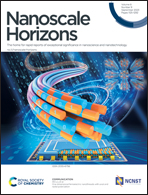One dimensional ferroelectric nanothreads with axial and radial polarization†
Abstract
Long-range ferroelectric crystalline order usually fades away as the spatial dimension decreases, and hence there are few two-dimensional (2D) ferroelectrics and far fewer one-dimensional (1D) ferroelectrics. Due to the depolarization field, low-dimensional ferroelectrics rarely possess the polarization along the direction of reduced dimensionality. Here, using first-principles density functional theory, we explore the structural evolution of nanoribbons of varying widths constructed by cutting a 2D sheet of ferroelectric α-III2VI3 (III = Al, Ga, In; VI = S, Se, Te). We discover a one-dimensional ferroelectric nanothread (1DFENT) of ultrasmall diameter with both axial and radial polarization, potentially enabling ultra-dense data storage with a 1D domain of just three unit cells being the functional unit. The polarization in 1DFENT of Ga2Se3 exhibits an unusual piezoelectric response: a stretching stress along the axial direction will increase both the axial and radial polarization, referred to as the auxetic piezoelectric effect. Utilizing the intrinsically flat electronic bands, we demonstrate the coexistence of ferroelectricity and ferromagnetism in 1DFENT and a counterintuitive charge-doping-induced metal-to-insulator transition. The 1DFENT with both axial and radial polarization offers a counterexample to the Mermin–Wagner theorem in 1D and suggests a new platform for the design of ultrahigh-density memory and the exploration of exotic states of matter.



 Please wait while we load your content...
Please wait while we load your content...